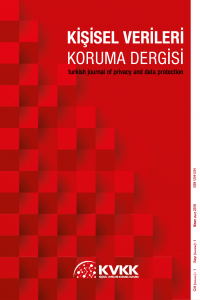6698 Sayılı Kanun’a Uyumlu Yazılımların Geliştirilmesi ve Yapay Zekâ Uygulamaları
Ülkemizde “Kişisel Verilerin Korunması” 6698 sayılı kanun (KVKK) ile tanımlanmış olup bu kanun, kurum ve şirketlerin; veri envanteri oluşturma ve bu envanteri güncel tutma, Verbis kaydı, aydınlatma metni ve açık rıza yükümlülüklerini gerçekleştirme gibi sorumlulukları sahiplenmesini beklemektedir. Kurum ve şirketlerin bu işlemleri kâğıt çıktılar ve personeller ile sistematik bir şekilde takip etmesi oldukça zor bir süreçtir. Bu süreci kolaylaştıracak, kanuna uyumlu yazılımların geliştirilmesi kurum ve şirketlerin bu kanuna uyumunu hızlandıracak ve kişisel verilerin koruma altına alınmasını sağlayacaktır. Bu çalışmada kanuna uyumlu yazılımların mimarisinin önemi ve kanundaki değişikliklere hızlı uyum sağlayacak yapay zekâ uygulamalarından bahsedilerek kullanıcıların farkındalığını arttırmak amaçlanmıştır.
Anahtar Kelimeler:
KVKK Yazılımı, KVKK Yazılım Mimarisi, KVKK Yapay Zekâ Uygulamaları, KVKK Software, KVKK Software Architecture, KVKK Artificial Intelligence Applications
Development of Software Compatible with Law No. 6698 and Applications of Artificial Intelligence
In our country the Protection of Personal Data was defined with law number 6698 (KVKK), and this law expects institutions and companies to have responsibilities such as creating a data inventory and keeping it up to date, Verbis registration, lighting text and performing explicit consent obligations. It is a quite difficult process for the institutions and companies to follow these transactions systematically via paper outputs and personnel. The development of law-compliant software that will facilitate this process will accelerate the compliance of institutions and companies with this law and ensure that personal data is protected. In this study, it was aimed to increase users’ awareness by mentioning about the importance of architecture of law-compliant software and artificial intelligence applications that will adapt quickly to changes in the law.
___
- Autoritédelaconcurrence, ve Bundeskartellamt. (2016). (Report on) Competition Law and Data.
- Basili, C. L. (2003). Iterative and Incremental Development: A Brief History. IEEE Computer.
- Beattie, A. (2019, Haziran 24). Technology: how the US, EU and China compete to set industry standards.
- Financial Times: https://www.ft.com/content/0c91b884-92bb-11e9-aea1-2b1d33ac3271
- Castelvecchi, D. (2016). Can We Open The Black Box Of Ai?. Nature News, sf: 20. doi: 10.1038/538020a.
- Copeland, B.J., (2017), Artificial intelligence (AI), Encyclopedia Britannica, Erişim tarihi: 12.Mart.2021, Erişim: http://bit.ly/2gdF3Aj.
- Çaycı, A.E. ve Çaycı, B. (2017). Dijital iletişim çağında teknolojinin açığa çıkardıkları: gözetim ve mahremiyet. The Turkish Online Journal of Design, Art and Communication, 7(1):36-46.
- J. V. Jeyakumar, et al. (2020). How Can I Explain This To You? An Empirical Study Of Deep Neural Network Explanation Methods.
- Kalender, A. U. (2020). Parçalı Bulutlar: Cloud Act ve Etkileri, Kişisel Verileri Koruma Dergisi. 2(2), 73-106.
- Kendall, K. E. (1992). Systems analysis and design. (Vol. 2). Prentice-Hall,.
- Kerr, O. (2017, 11 27). Microsoft Challenged the Wrong Law. Now What? lawfareblog.com: https://www.lawfareblog.com/microsoft-challenged-wrong-law-now-what.
- Ketizmen, M., Kart, A. (2019). Kişisel Veri ve Rekabet Hukuku Kapsamında “Big Data”, Kişisel Verileri Koruma Dergisi. 1(1), 64-76.
- Kişisel Verileri Koruma Kurumu. (2019). Kişisel Verilerin Korunması Kanununa İlişkin Uygulama Rehberi.https://www.kvkk.gov.tr/SharedFolderServer/CMSFiles/41784a70-2bac-4e4a-830f-35c628468646.PDF, Erişim tarihi: 12.Mart.2021.
- Kocabaş, ¸S., (09.03.2013), Yapay Zeka | Amacı ve Tarihçesi | Gelecek’te Yapay Zeka, Erişim: http://bit.ly/2kTW1ss, Erişim tarihi: 12.Mart.2021
- Pendergast, T. (2018, Mart 28). The Next Cold War is Here, and It's All About Data. Wired.com: https://www.wired.com/story/opinion-new-data-cold-war/
- Reis Z.A., (2018), Erişim: https://www.elektrik.gen.tr/wp-content/uploads/2018/01/1.-Yapay-Zeka.pdf, Erişim tarihi: 12.Mart.2021.
- Saygı, S. (2020). 6698 Sayılı Kanun’un Sistematiğinde Yargısal Başvuru Yolları. Kişisel Verileri Koruma Dergisi. 2(2), 30-60.
- Seker, S. E. (2014). Bilgi Yönetimi (Knowledge Management). YBSAnsiklopedi , 1 (2), 8-14.
- Seker, S. E. (2014). BT Projelerinde Yaşanan Problemler ve Çözüm Önerileri. YBSAnsiklopedi , 1 (3), 18-21.
- Seker, S. E. (2014). Yazılım Geliştirme Hayat Döngüsü (Software Development Life Cycle). YBSAnsiklopedi , 1 (2), 2-5.
- Seker, S. E. (2015). Saldırgan Yazılım Geliştirme (Scrum Software Development). YBSAnsiklopedi , 2 (1), 12-15.
- Thompson II, R. M., & Cole, J. P. (2015). Stored Communications Act: Reform of the Electronic Communications Privacy Act. Congressional Research Service.
- Üstün Y. ve Günal A. N., (2020). İş İlişkilerinde Bazı Yaygın Uygulamaların Kişisel Verilerin Korunması Kanunu Kapsamında Değerlendirilmesi, Kişisel Verileri Koruma Dergisi. 2(2), 61-74.
- Zeiler, M. D. et al. (2014). Visualizing And Understanding Convolutional Networks. Springer, Cham, sf: 818-833. doi: 10.1007/978-3-319-10590-1_53. |
- ISSN: 2667-6524
- Yayın Aralığı: Yılda 2 Sayı
- Başlangıç: 2019
- Yayıncı: Kişisel Verileri Koruma Kurumu
Sayıdaki Diğer Makaleler
6698 Sayılı Kanun’a Uyumlu Yazılımların Geliştirilmesi ve Yapay Zekâ Uygulamaları
The Privacy Paradox Is Not Real
Yüz Tanıma Teknolojilerinin Kişisel Verilerin Korunması Hukuku Açısından İncelenmesi
AB ve Türk Hukukunda Veri İhlalinin Tespiti ve Bildirim Süresinin Karşılaştırmalı Değerlendirmesi
